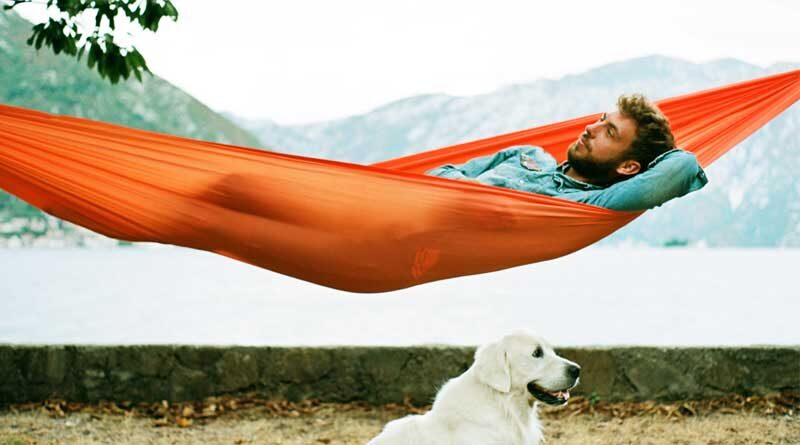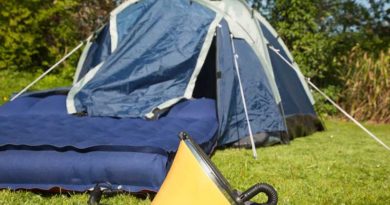How to Sleep Comfortably in a Hammock?
A lot of people have a misconception about hammock camping that all you need to do it is just a hammock to sleep comfortably and in some sense, that may be true. In my opinion, 90% of the time that’s not the case. You need more than just a hammock. A hammock might do in ideal conditions, for example, if it’s the middle of the summer when it’s not raining, it’s dry out, or it’s warm. In these conditions, maybe you get away with just a hammock but in most conditions, you’re going to need a lot more than the hammock.
Which Hammock should you choose?
There’re a lot of companies making hammocks and what I use is the ENO SingleNest. It’s a simple nylon hammock, real cheap, lightweight, and compact. They’re also comfortable and durable enough. I’ve had never any issue with them tearing or anything like that. They come with a pouch built-in to the hammock and carabiners built right into the nylon fabric.
The downside to the nylon fabric is that it is paper-thin, probably thinner than paper. The issue you run into is when it’s windy out. Your bareback is on this hammock when there’s a gust of wind, heat is get sucked right out of your body. This provides almost no insulation from the elements whatsoever. Since you’re raised up above the ground, you have the wind going below you, around you, and on top of you. So this is the major concern with these nylon hammocks.
They do make hammocks thicker than this and you can invest in that. They cost a little bit more money, weight and they’re a little bit bigger. But if you’re starting out, a simple nylon hammock will do the job. Also, there’re other items you can buy to address that issue.
You need a Sleeping Bag with a Hammock
You also need a sleeping bag to sleep comfortably in a hammock. Obviously, in cold temperatures, you want a nice winter bag. If you’re in the summertime, you can get away with something else. You’re flexible on your sleeping bag but you’re going to need it along with everything else.
The other option is an underquilt. As I mentioned earlier, the nylon is very thin and you’re going to freeze because that wind blows right underneath and sucks all of your heat away. Well, an underquilt prevents that. It goes underneath your hammock. There’re also topquilts that go over the top of you but you lose more heat underneath of you than you do over top.
I use the Outdoor Vitals Underquilt and it’s interesting that it could be used as a sleeping bag. So this one, you could have it just as an underquilt or you can zip it up and it will completely enclose you as a kind of pod going all the way around your hammock.
Consider a Rain Tarp
Just in case it starts raining or if there’s any debris falling off the tree, you need a nice tarp above you to protect from that. Now a tarp will protect you from the rain but it also helps insulate you depending on how you set the tarp and different configurations. If you set it up nice and close to you, it’ll help keep that air in that space warm. You can also set the tarp off to help prevent the wind from blowing over the top of you. So a good tarp is something you’re going to need.
You can also use a tent rainfly from one of your tents and it will work. It’ll keep the sun off of you but it might not keep you dry. So keep that in mind. All you have to do some modifications like changing the tarp to suit your needs. First, to keep the peak up, have the ridgeline run under the tarp. Then sew on loops of nylon webbing into the long ends of your tarp where the pole connects. This is awesome because a tent rainfly pack down super small and they fit in the hammock bag.
Sleeping in a Hammock with your Partner
A short nap in a hammock with your partner could be fun but hammocks are not for long term sleeping for two people. You end up squished together and you’re forced into the lowest spot and a distorted lay. In fact, a double hammock is a misnomer of bad advertising. You never feel comfortable and you continuously toss and turn all the time. On the other hand, if you’ve got an ultralight partner, you could sleep with them on top of you. Otherwise, sleeping in a hammock side by side seems impossible.
So it’s always a good idea that you should bring two hammocks. In my opinion, always go for a double hammock even if you’ll be sleeping alone. A double hammock allows more room for you and you can sleep diagonally, which is super comfortable. As I said, I got the ENO SingleNest but I wish I’d have gotten their DoubleNest, which is supposed to be a 2-person hammock and a little wide. This SingleNest, when I’m in the hammock, it kind of constrains me a little bit.
Sleep on your Side in a Hammock
You can sleep on your side in a hammock but it depends on a few factors; first, how tall you are, second, how long your hammock is, and finally, the width of your hammock. Also, you’ll need a long enough hammock hung with a good bit of sag to get comfortable on your side. Do not lie like a banana because you get an arch uncomfortable in your back. Just stretch the sides, move your feet over to the corner, create almost like a foot-box for you, and then adjust your body so that you’re lying fairly flat. You won’t feel any discomfort in any area of your body and it’s like you’re lying in your bed.
Now for side sleeping, dig out a little spot for your feet (create that little foot-box), grab a pillow, and lay on your side. It does take a little bit of adjustment but once you find the sweet spot, you’re good to go. As long as you don’t roll around and toss and turn all night, you can stay very comfortable all night.
Hammock with Spreader Bar vs. without
Some people ask; what is the difference in comfort when sleeping in a hammock with a spreader bar and without a spreader bar? Well, it comes down to your personal preference and there’s not a right and wrong way to describe it. However, non-spreader bar hammocks are considered more comfortable because the fabric is free to move around and you can adjust your body easily. On the other hand, the fabric is touted against the spreader bar and it does not allow plenty of adjustment.
Consider a Bug Net
The worst possible thing that could happen to you when you’re about to take a nap is to be eaten alive by bugs. So you’re going to need a bug net because it’s effective against mosquitos, black flies, and other insects that you don’t want to be in your space while you’re in your hammock.
Does Sleeping in a Hammock Hurt your Back?
In general, sleeping in a hammock does not hurt your back once you know how to properly use it. In fact, your back feels more supported and you feel like you can lie there all day. Also, you toss and turn a lot less in the hammock and it holds you perfectly. A hammock also forces you to sleep on your back so side sleeping and stomach sleeping may not be comfortable for most people.




